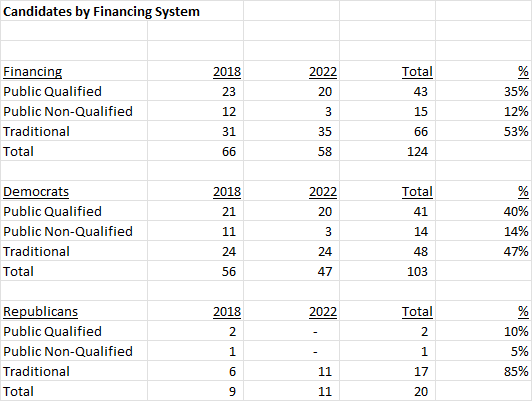By Adam Pagnucco.
Part One laid out the history and basic characteristics of Montgomery County’s public campaign financing system, which was designed by former Council Member Phil Andrews. Now let’s start seeing how it performed in the last two cycles.
First, the table below shows the number of candidates in 2018 and 2022 who used public and traditional financing. The term “qualified” refers to whether a candidate in public financing received enough contributions from county residents to qualify for public matching funds.

Almost half of candidates for county executive and county council used public financing in the last two cycles. Of those, 43 candidates in public financing qualified for matching funds and 15 did not.
While use of the two systems is roughly equal, publicly financed candidates have won most of the elections. In 2018, the county executive and 6 of the 9 council winners used public financing. In 2022, the county executive and 7 of the 11 council winners used public financing.
The table below shows the totals raised by campaign finance system in 2018 and 2022.

Now let’s acknowledge that the data is skewed by at least two elements: David Blair’s self-financing in his two county executive races and the frequent non-competitiveness of many traditional candidates. (Non-competitive public financing candidates did not acquire public matching funds.) With those caveats in mind, it’s clear that the system did exactly what Phil Andrews intended: it gave publicly financed candidates enough resources to compete and win against those who stayed in the traditional system. County Executive Marc Elrich’s use of public funds to win two (close!) races over Blair is evidence of that all by itself.
There is more. Women often struggle to raise as much money as men in elections. However, there is a bit of evidence that the county’s public financing program has eased that gap. The table below shows money raised by gender for council candidates in the last two cycles.

Among council candidates who were publicly financed and qualified for matching funds, women raised 83% of the money raised by men. Among council candidates in traditional financing, women raised 70% of the money raised by men.
The table below shows money raised by race for council candidates in the last two cycles.

There are sample size issues that constrain this data. That said, Black and Latino candidates appear to be more financially competitive in public financing when they qualify for matching funds than in traditional financing.
Finally, incumbents do just as well with public financing as they do with traditional financing measured by their electoral success. Elrich, who uses public financing, is undefeated in executive elections even with many millions deployed against him. In council races, five incumbents (Craig Rice in 2018, Tom Hucker in 2018, Will Jawando in 2022, Andrew Friedson in 2022 and Sidney Katz in 2022) used traditional financing and all of them won. Five other incumbents (Hans Riemer in 2018, Sidney Katz in 2018, Nancy Navarro in 2018, Evan Glass in 2022 and Gabe Albornoz in 2022) used public financing and all of them won. The best guarantee for the survival of public financing is when incumbents use it and win because they will keep it in law and funded.
Let’s put this in perspective. This is one system in one county used in two election cycles. That makes this data far from conclusive. But so far, at least in our county, the system designed by Phil Andrews is frequently used, makes participating candidates competitive (including through winning elections) and has benefited women and people of color. It has also posed no threat to incumbents.
We are just getting started. We will start looking at where the money in public financing comes from next!
